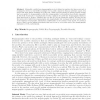Free Online Productivity Tools
i2Speak
i2Symbol
i2OCR
iTex2Img
iWeb2Print
iWeb2Shot
i2Type
iPdf2Split
iPdf2Merge
i2Bopomofo
i2Arabic
i2Style
i2Image
i2PDF
iLatex2Rtf
Sci2ools
EUROCRYPT
2004
Springer
2004
Springer
Public-Key Steganography
Informally, a public-key steganography protocol allows two parties, who have never met or exchanged a secret, to send hidden messages over a public channel so that an adversary cannot even detect that these hidden messages are being sent. Unlike previous settings in which provable security has been applied to steganography, public-key steganography is information-theoretically impossible. In this work we introduce computational security conditions for public-key steganography similar to those introduced by Hopper, Langford and von Ahn [13] for the private-key setting. We also give the first protocols for public-key steganography and steganographic key exchange that are provably secure under standard cryptographic assumptions. Additionally, in the random oracle model, we present a protocol that is secure against adversaries that have access to a decoding oracle (the steganographic equivalent of CCA-2 adversaries). Key Words: Steganography, Public-Key Cryptography, Provable Security
Cryptography | EUROCRYPT 2004 | Provable Security | Public-key Steganography | Public-key Steganography Protocol |
| Added | 01 Jul 2010 |
| Updated | 01 Jul 2010 |
| Type | Conference |
| Year | 2004 |
| Where | EUROCRYPT |
| Authors | Luis von Ahn, Nicholas J. Hopper |
Comments (0)

